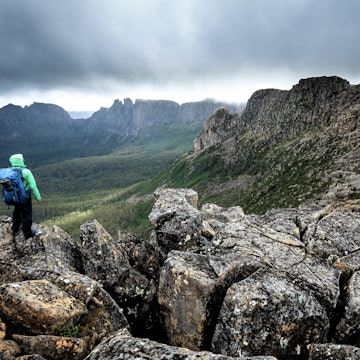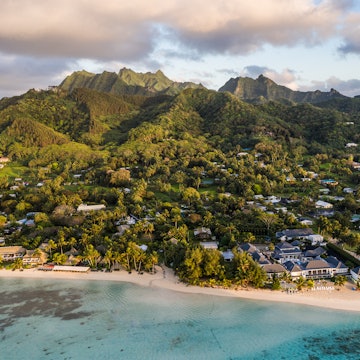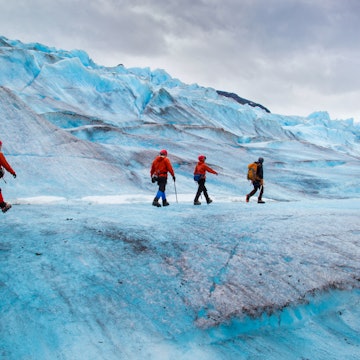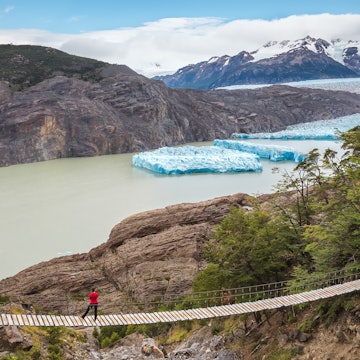
This is your brain on Antarctica: penguins, icebergs, and a lifetime supply of awe

Apr 4, 2022 • 17 min read

A trip to Antarctica offers equal parts adrenaline-pumping adventure and quiet contemplation.
Editor-at-large Sebastian Modak returned from Antarctica as a changed person – and it turns out science can explain why.
Something funny happened whenever I spotted a whale in Antarctica. It was as involuntary as breathing and occurred regardless of species. As I caught the glistening outline of an orca's dorsal fin or the triumphant fluke of a humpback, I let out a deep, sustained laugh. Different from the laugh of polite society, this was a more primal reaction; the sound of my brain short-circuiting as it tried to make sense of something too big to comprehend.

Over the course of ten days sailing around the Antarctic Peninsula, I noticed that the laughter — often accompanied by a long, drawn-out, perplexed “Whaaaat?!” — emerged in other situations, too. There were the 10 p.m. sunsets, hour-long spectacles that turned the snow-covered mountains the color of fire, then strawberry sherbet, then wet lavender. There were the thousands-strong penguin rookeries — you can hear and smell them before you even see them — gathered together at impossible heights, crisscrossed with “penguin highways,” paved by the tireless commute back and forth to the water below. There were the hours spent in a kayak, listening to the quiet fall of snow on the sea before it was suddenly interrupted by the thunderous crack of a glacier calving somewhere.
In all of those moments, I felt unbridled joy and endless gratitude: this place exists and I am here. But there was something else too, something that took me a long time to identify, because I wasn’t used to this much of it, this often. It was, I realized, a never-ending, relentless, all-consuming avalanche of awe. By my second or third day on the continent, I was reorienting my expectations. Going to Antarctica was not just a glimpse at one of the least-visited places on Earth. It was not only a once-in-a-lifetime window into what this planet looks like without us. Antarctica, I realized, was doing something irrevocable to my brain.
Antarctica: your guide to adventure
Heading all the way south

Traveling to Antarctica isn’t easy. Besides the limitations of space (it’s far) and time (it’s not exactly fit for a weekend jaunt), it’s also prohibitively expensive for most of the world – expedition cruises average around $12,000 per person. It is becoming more popular though. What started as a trickle (a few hundred, half a century ago) has ballooned to more than 70,000 in the 2019-2020 season.
Those numbers come from the International Association of Antarctic Tour Operators (IAATO), an organization founded by seven companies in 1991 as a way to regulate tourism in the region through a set of agreed-upon environmental and safety guidelines. Today, IAATO has grown to include over 100 different member organizations, including tour operators, travel agents, and nonprofits. Member tour operators follow strict rules including a limit of 100 people on landing sites at a time and restrictions around interacting with animals.

A 1959 treaty signed by 12 countries that had scientific operations on the continent at the time declared Antarctica “a natural reserve devoted to peaceful purposes only.” Any company wishing to operate in Antarctica needs sign off from the treaty countries. While a handful of countries have made claims to parts of the continent in the form of research and military bases, it’s the territorial equivalent of screaming into the void, as many of those claims remain unrecognized. The tourism industry works similarly: a kind of handshake agreement that sees each company self-regulating per some consensus-based guidelines.
Most organized group trips arrive by sea, with most of those departing either from Ushuaia, Argentina or Punta Arenas, Chile. My trip, booked with Aurora Expeditions, an Australian company that has been an IAATO member since 1995, skipped the notoriously rough Drake Passage with a short flight from Punta Arenas onto a gravel airstrip on King George Island in the South Shetland archipelago just north of the Antarctic mainland. I was treated to a quick and firm slap of awe before the journey had even really begun.

I stepped off the four-engine BAE-146 and found myself immediately transfixed by the horizon. Just beyond the brown gravel of the runway and the containers serving as research labs for the Chilean and Russian bases on this corner of the island, I saw fields of untouched snow stretching into infinity. In another direction, a glacier, looking like a wall of ice rising from the sea. Cresting over the hill, the sun sparkled onto the Southern Ocean and I saw our ship, the Greg Mortimer, unmistakable from its state-of-the-art inverted bow, backdropped by a chain of black mountains, speckled with the previous days’ snowfall. Right on cue, I laughed.
How to pack for a trip to Antarctica
Where plans disappear
Any expedition trip is unpredictable, but in arguably the most inhospitable place on the planet, there truly is no such thing as an itinerary. Maps of Aurora Expeditions' “Antarctic Explorer” trip show a route leading to a circle encompassing a wide area around the Antarctic Peninsula. The implication is clear: we’ll figure it out when we get there. Led by an expedition staff that included, among others, a former British commando, a Swedish explorer who once followed in the footsteps of the legendary explorer Fridtjof Nansen by crossing Greenland overland, and a journalist-mountaineer who also worked as a consultant for the animated penguin movie Happy Feet, that’s exactly what we did.

Our general plan – and that of most expedition cruises to Antarctica – was to follow the west coast of the Antarctic Peninsula where summer conditions are mostly good and a diversity of wildlife experiences can be had in a short amount of time. By the end of the second day, after stops at a chinstrap penguin colony on Half Moon Island and the ghostly remains of a whaling station on Deception Island, we had left the South Shetlands, crossed the Bransfield Strait, and were approaching the Antarctic mainland.
Every day started around 6:30 a.m. with a wake-up announcement from expedition leader Howard Whelan – the Happy Feet guy – explaining where we were and where we were heading. The Greg Mortimer usually hosts around 130 guests, but this being one of the first trips back since the Covid-19 pandemic shut down virtually all cruises, it only carried 54. It made social distancing easy and moments of quiet contemplation plentiful.

It is a well-appointed ship, with a cozy library, a sauna, and two hot tubs, but I barely partook in any of the amenities. It felt like I’d be missing the point to spend an hour with my eyes closed getting a massage when I could be up on one of the viewing decks while we squeezed through the Lemaire Channel, cracking through drifting ice like a hammer shattering peanut brittle; when I could be counting Antarctic terns and Cape petrels as part of a citizen science campaign; when I could be watching icebergs pass by like the ghosts of lost ships. The price tag associated with any trip to Antarctica means there’s a natural tendency toward luxury, but even the shiniest offerings on other ships – private butlers, free-flow caviar, a city block worth of restaurants – seem like cheap distractions from the real show.
When not participating in landings (usually two a day) or activities (kayaking and snorkeling were offered for an extra charge), I spent hours out on the deck. My brain did somersaults to grasp the scale of this place (1.4 times the size of the United States), the brutality of its surrounding sea and ice (a hauntingly long list of ships sunk and lives lost), and the threat we humans pose (149 billion metric tons of melted ice a year). The awe kept coming in such a torrent that it temporarily buoyed me past any self-doubt about whether I should be here and towards something resembling pure joy.
Into the Weddell

On the fourth day of the expedition, we were called into the lecture hall for an update on the plan. A map on the screen showed a thin band of intense winds that would be buffeting down the peninsula. We wouldn’t be able to operate in 40-knot gales, the team explained. So instead, we’d be turning around and making a beeline north where we would spin around the tip of the peninsula. From there we would enter the Weddell Sea, a place that looms large in the imagination of anyone who has ever dreamed of going to Antarctica.
The Weddell Sea is a place that is famous for ice; murderous, vengeful ice that destroys ships and crushes dreams. Most well-known is the story of Ernest Shackleton, who entered these waters in 1914 on a quest to be the first person to cross Antarctica overland. In the early months of 1915, his ship – the Endurance – became trapped by sea ice. By November, the ice had crushed the ship into splinters. Shackleton would go on to successfully lead his crew of 27 men on an audacious journey across hundreds of miles of ice and sea, cementing his reputation as one of the world’s great adventurers and the Weddell Sea’s reputation as one of the world’s most treacherous stretches of water. Just as we entered the Weddell Sea from the west, another ship was beginning its journey further east. On March 9, a month after I returned from Antarctica, the Endurance22 expedition announced that it had located and photographed the wreck of the Endurance for the first time since it was taken by the treacherous Weddell Sea.
This was not that Weddell Sea. On this Weddell Sea, the way through the mirror-still water was mostly clear. The sea – for days the color of molten silver under thick clouds – turned Gatorade blue under the summer sun. This was an extraordinary stroke of luck: I sensed genuine joy among even the more seasoned expedition staff as the Weddell is often impassable. But the unusual conditions were also indicative of climate change’s effect on this part of the planet. Some years are colder or warmer than others, but there’s no doubt that there’s considerably less ice than there was in Shackleton’s time.

“In more than 25 years of coming to Antarctica, I’ve never seen so little ice in the Weddell Sea,” Whelan, the expedition leader, said as we made our way south. And the changes aren’t just on the eastern side of the peninsula. Whelan pointed to Deception Island – a volcanic landscape of browns, blacks, and reds we had encountered days earlier – as a place that he remembered as being perpetually blanketed in snow. When we went, it resembled a desert.
Shortly after our conversation, there was another announcement. We would be taking advantage of the navigable conditions and making an unplanned landing that caused a murmur of excitement among those in the know: Snow Hill Island. People come to Antarctica dozens of times and never make it to Snow Hill. A trip into the Weddell Sea and a landing at Snow Hill on my first trip ever? That night, I drank to the thousands of exceedingly unlucky Antarctic explorers who had come before me.

For any uninformed observer, the beach we landed at on Snow Hill wouldn’t be much to cheer about. Despite the name, there was only a dusting of snow. There was nary a penguin in sight. The ground was covered in mud that stuck to every ridge in my boots. But just up a small plateau, I saw a little wooden hut. Nearby, there was a circle of tents belonging to an Argentinean restoration crew who were here for a few weeks for restoration work on the hut, first built by the Swedish geologist Otto Nordenskjöld in 1902. He and a handful of other members of the Swedish Antarctic Expedition had intended to spend one winter there, but after their relief ship, the Antarctic, was crushed by ice (sensing a pattern?), one winter became two winters. It turned into a legendary – though unsung in comparison to Shackleton’s – story of survival. But Nordenskjöld’s research on the island also led to groundbreaking discoveries in paleontology, meteorology, and geology.
I didn’t know any of this until about 20 minutes before making landfall, so I couldn’t fully process the awe of being face to face with this particular moment in history. But, like absorbing awe by proxy, I watched others take it in. Antarctica can mean different things to different people, but its power to move us was revealing itself as largely universal.
NASA releases a 48-year time-lapse of Earth’s changing glaciers
Are ambassadors enough?

There is a line that is often repeated by those visiting places on the frontline of climate change. It goes something like this: “Yes, climate change is an existential threat, but by seeing its effects up close, you are becoming an ambassador for the cause.” The Antarctic Peninsula – where I spent ten days on a relatively efficient, but still diesel-guzzling ship – is one of the fastest-warming areas on Earth, having heated up by around 2.5 degrees Celsius (4.5 degrees Fahrenheit) since 1950. Rising sea levels aren’t even the only thing we have to worry about. As giant ice shelves break off into the sea, fresh water melts, changing salinity levels and setting off a whole array of cascading effects on ecosystems and weather patterns. Are ambassadors worth it if the alternative is staying at home?

There isn’t an easy answer, especially because creating ambassadors isn’t the only positive effect tourism has in Antarctica. Whelan, for example, told me of how in the early days of Antarctic tourism, some scientific bases often resembled trash dumps. “When I first started coming to Antarctica, it wasn't the pristine place that everybody keeps raving about,” Whelan said, before regaling me with horrifying stories of plane crash debris bulldozed out onto the sea ice to float away and rusty barrels of fuel leaching into the ground for months at a time. As tourists arrived they started spreading the word about these abuses. “Suddenly governments were saying, ‘Oh no – people are looking,” Whelan said. With tourism came new standards around interacting with the environment, some of the most stringent on earth.
Gina Greer, executive director of IAATO, pointed out another benefit of tourism. “A lot of the guides and naturalists that are down there have been going to the same sites for a long period of time, so they're able to spot things that maybe others in the scientific community may not be aware of,” she said. Whether it’s in documenting the year-to-year changing demographics of an island – the tuxedo-clad Adélie penguins, for example, have been drastically shifting their breeding grounds recently — or levels of ice, tourism-focused expeditions can be important support players in the scientific community.
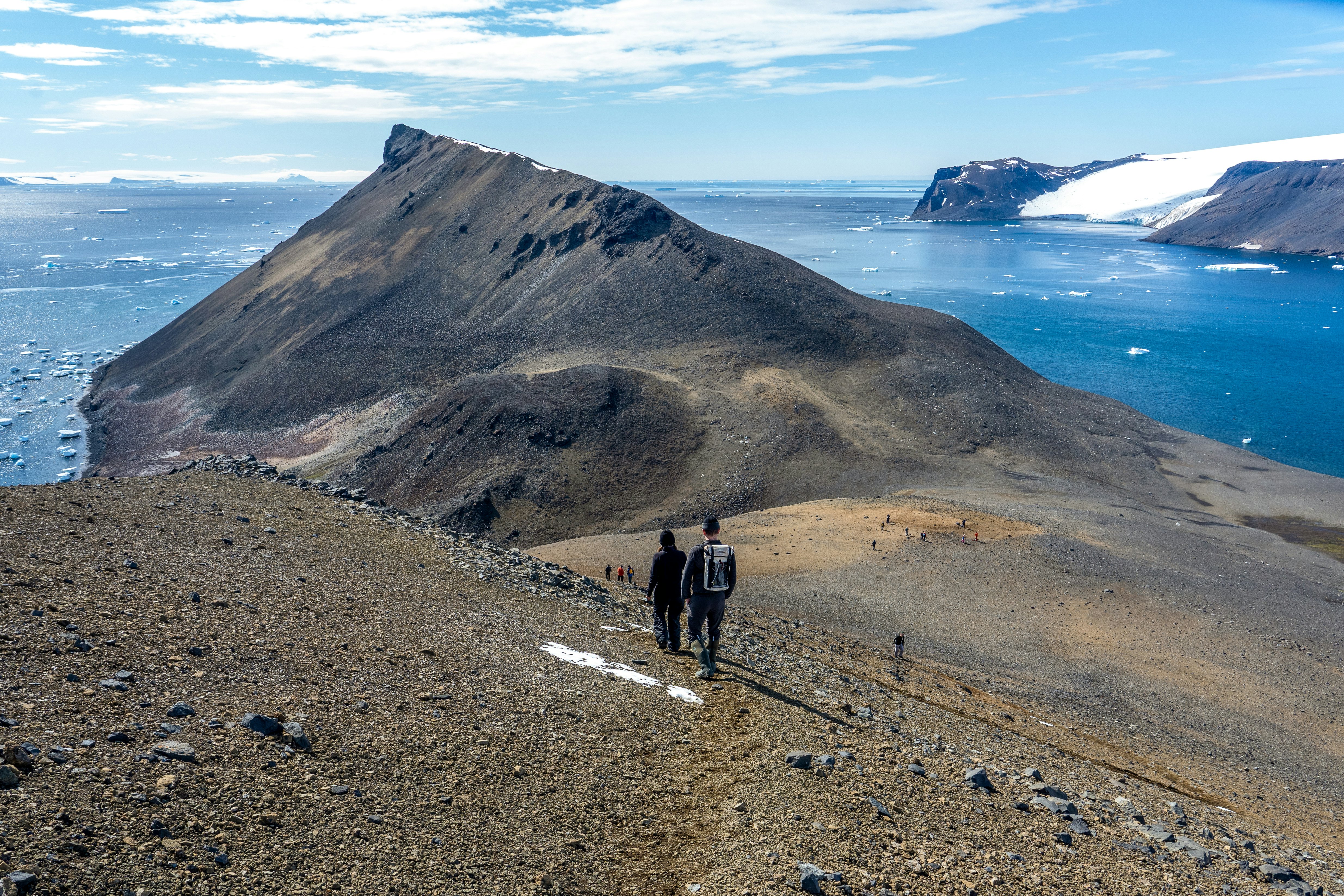
And Greer also believes we shouldn’t undervalue the power of Antarctica to change minds. Ambassadorship, while arguably overused, does have value. In fact, she sees that as one of the reasons IAATO exists. “If someone goes to Antarctica and they don’t come back as a changed person with new goals, new perspectives, and a desire to share what they’ve experienced with others, then that is a lost opportunity for us,” she said.
Along with the passion that many tour operators bring to environmental education on their trips and the wide set of regulations they must follow, the past fifty years have seen major leaps in sustainable technology and carbon offsetting possibilities. But with each nod of approval for each new step towards sustainability, comes the inevitable question: Is it better that tourists don’t come at all and we leave Antarctica to the scientists?
The eternal lure of icebergs: fulfilling a life-long dream of visiting Antarctica
So much awe in so little time
I am not a scientist but I am a different person than I was before I went to Antarctica. Awe can have that effect.

“Awe is a difficult emotion to define,” said Michiel van Elk, a professor of cognitive psychology at Leiden University in the Netherlands. His interest in the emotion has led him towards research not only on the awe-inspiring properties of nature but also on psychedelics and religion. One part of that definition though is what the academic literature calls “a need for accommodation.”
“Awe can happen when, based on an experience, you need to revise your mental schemes; you need to update your model of the world to incorporate this information,” Van Elk said. “Over the past two decades, people have tried to nail it down, but I think we have to acknowledge that it is actually this multifaceted emotion that combines a lot of different components.” As a result, perhaps because of its complexity, there’s been a large amount of research on the benefits of experiencing awe, including how it can be an effective tool in combating stress, how it can make us feel at once smaller and more connected to each other, and even how awe may have anti-inflammatory properties.

I don’t know what it was doing to my immune system, but as the awe kept coming, I felt waves of what I can only describe as joy. I could crouch and watch Gentoo penguins stumble and fall over each other for ten minutes and it felt like an eternity had passed. I fell asleep in a matter of seconds every night and woke up groggy from mental overexertion. I felt present.
This kind of response to awe isn’t unusual according to Van Elk. One study he led, for example, found that feelings of awe were associated with a decrease in activity in the brain’s “default mode network,” a group of brain areas responsible for the detritus of daily life including daydreaming and rumination. In other words? “When people feel awe they are completely immersed in the experience and they have fewer cognitive resources left for self-reflection and mind-wandering,” Van Elk said.
Quarantine with penguins: life stuck onboard an Antarctica cruise ship
What’s less clear is whether the positive effects of awe can outlast the awe-inducing experiences themselves: that kind of longitudinal research, Van Elk says, isn’t as available. For me, it is probably too early to know what Antarctica did to me in the long run; could it be, for example, something akin to the new perspective astronauts report having after returning from space? Harder still is to know how the experiences affected all the other travelers on my ship – or the thousands who have traveled on other ships. Any attempt to justify the carbon footprint of my trip with talk of its transformative power will come across as preemptively defensive. But also, any conclusion that we’re all better off staying at home ignores the mind-bending power of seeing Antarctica up close.

By the seventh day onboard the Greg Mortimer, the laughter hadn’t stopped. I laughed in awe when I found myself alone beneath falling snowflakes peering under a rocky overhang at a nest of snow petrels. I laughed when, on my first kayaking outing, I floated above the Antarctic equivalent of an all-you-can-eat buffet, minke whales, humpbacks, and Gentoo penguins surrounding me as they feasted on the krill that lay just below. And then there was the afternoon in Cape Gordon, a quiet inlet by Vega Island towards the tip of the Antarctic peninsula.
Ricocheting off the ice and rock, I heard the tell-tale hiss of air and mist shooting out of a blowhole, followed by a second one. Then, just as our Zodiac boat got into position ahead of the humpback whales, one of them breached. Fins to its side, it shot up like a rocket and body-slammed into the water. Then again. For 20 minutes the pair circled us, one of the whales flapping its fin against the water, then disappearing before breaching again. They danced to the backdrop of electric-blue icebergs and low-hanging clouds. I tuned out the commentary by the naturalist steering the Zodiac. For this moment, there was only me, these creatures, and this place.
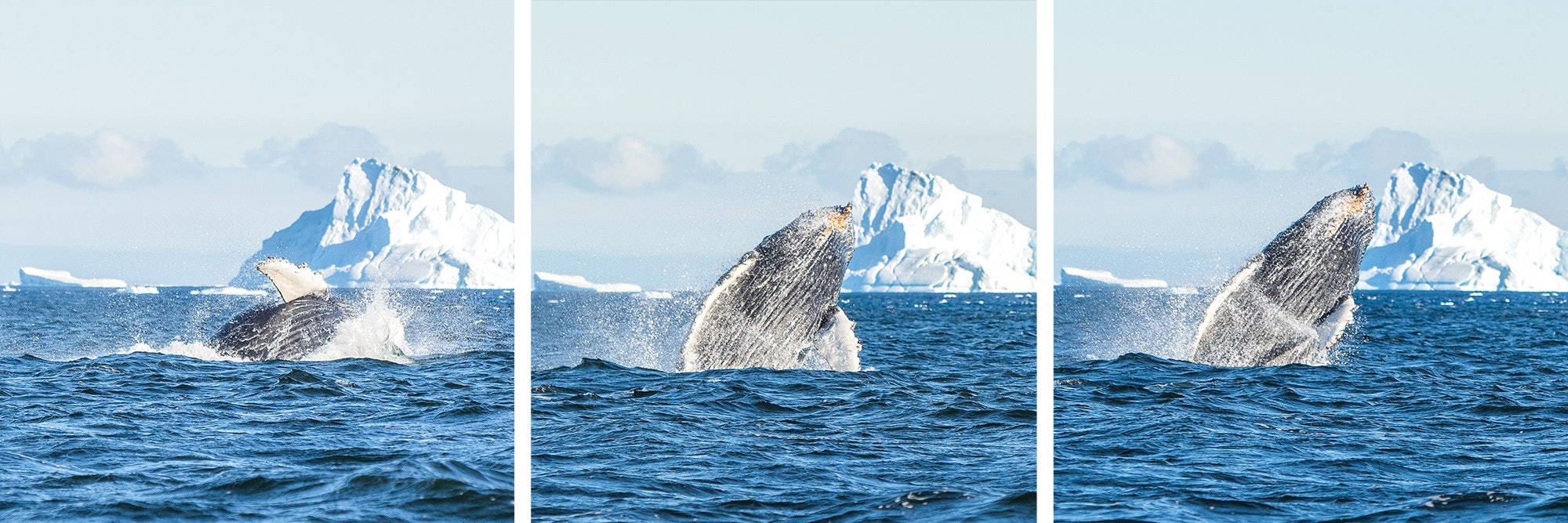
Back on the ship, I debriefed with Isabelle Howells, an expedition guide who days earlier had given a lecture on the whales of Antarctica. She explained that what we had seen was a mother and her calf. From the size of the calf, and considering migratory patterns, this was probably the calf’s first time in Antarctica. “They were celebrating,” Howells said with a smile. I like to think they were laughing, too.
You might also like:
Ask LP: how can I travel to Antarctica?
Is it sustainable to visit Antarctica?
Explorer shares amazing images of adventures to Everest and the Poles
Sebastian Modak traveled to Antarctica with support from Aurora Expeditions. Lonely Planet contributors do not accept freebies in exchange for positive coverage.






